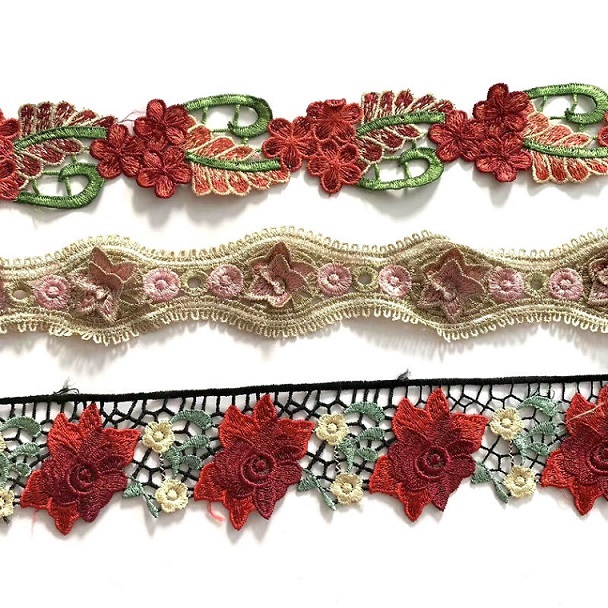
- English
- Español
- Português
- русский
- Français
- 日本語
- Deutsch
- tiếng Việt
- Italiano
- Nederlands
- ภาษาไทย
- Polski
- 한국어
- Svenska
- magyar
- Malay
- বাংলা ভাষার
- Dansk
- Suomi
- हिन्दी
- Pilipino
- Türkçe
- Gaeilge
- العربية
- Indonesia
- Norsk
- تمل
- český
- ελληνικά
- український
- Javanese
- فارسی
- தமிழ்
- తెలుగు
- नेपाली
- Burmese
- български
- ລາວ
- Latine
- Қазақша
- Euskal
- Azərbaycan
- Slovenský jazyk
- Македонски
- Lietuvos
- Eesti Keel
- Română
- Slovenski
- मराठी
- Srpski језик
Main raw materials and characteristics of lace production

Nylon:
Nylon, also known as nylon, has the advantages of high strength, good wear resistance and high elasticity. It was first produced by the DuPont Company in 1939. In the early stage of our country, coal tar and petroleum cracking products were firstly made into monomer, then fiber macromolecule was made through polymerization or condensation reaction, and then fiber was made through spinning and post-processing.
Polyamide macromolecules contain polar amide and non-polar methylene, so it has medium moisture absorption, both ends of the macromolecule contain amino and carboxyl groups, with positive charge in the acidic medium, available acid dye dyeing.
The color yield of polyamide 6 is much stronger than polyamide 66. It has poor stability to acid and oxidant at room temperature, but stable to alkali and ammonia water. In addition, its poor light resistance, long time according to, will cause macromolecular chain fracture, temperature drop, color yellow, considering the production of lace yarn tensile force and strength requirements are relatively high, compared with other fibers, nylon has become one of the important production materials of lace.
Polyester:
British chemists produced polyethylene terephthalate fiber, and put into production after 1949, called it polyvinyl fiber, our country is called polyester, polyester thermal stability in several main synthetic fibers is the best, its chemical stability is related to its chemical structure, in the molecular chain, benzene ring and methylene are stable. The ester group in the structure is the only group that can react chemically. Polyester hydrolyzes under the action of alkali, and the degree of hydrolysis varies with the type, concentration, temperature and time of alkali. Polyester has good acid resistance and high stability to oxidant and reducing agent.
Due to its tight molecular chain, no specific dyeing groups, small polarity, lack of hydrophilicity and low degree of puffing in water, polyester is more difficult to dye and has poor stain ability. This is because there is no room for dye molecules between polyester's long, winding chains, so they can't easily get into the fibre.
Disperse dyes are generally used for dyeing, dyeing methods include: carrier dyeing, high temperature and high pressure dyeing and hot melt dyeing. Due to the high initial modulus of polyester, poor extensibility and resilience, the creases generated in the wearing process are difficult to eliminate. Therefore, polyester is mostly used as the edge line of the bag in the women's underwear lace. Due to the poor comfort of polyester, it is not suitable for use in the lace of intimate wear, but it can be used in some decorative clothing for external use. The lace produced with polyester as the main raw material is relatively crisp, low cost, suitable for use on the clothing worn outside, play the role of embellishment.
Cotton fiber has the characteristics of moisture absorption, breathable, soft and comfortable is the ideal lace raw material, cotton fiber after finishing, enhance its tension and strength, can be used for a variety of fancy lace organization.
Rayon:
Viscose fiber is the main variety of artificial fiber, rich raw materials and excellent performance, especially in terms of absorption and air permeability, there is no synthetic fiber can be comparable.
Due to oxidation in the process of production, the carboxyl and aldehyde groups in cellulose are higher. Its wet temperature is only about 50% of the dry temperature, generally speaking, its dyeing properties, similar to cotton fiber, dyeing cotton fiber dyes, can be used to dye viscose fiber, and can obtain bright color, low temperature short time dyeing, the color is lighter than cotton; High temperature long time dyeing is deeper than cotton, lace dyeing is mainly used reactive dyes and direct dyes. Viscose silk has good hygroscopic and breathable properties, smooth and soft feel, but poor elastic recovery is easy to wrinkle, so viscose silk is often used for weft lining tissue.


